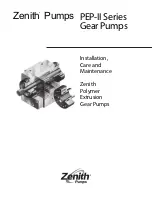
4
Power Supply
Technical Information
●
Input Variation Influence
The variation in the output voltage occurring when only the input
voltage is changed slowly over the input range while maintaining
constant output conditions.
●
Load Variation Influence
The variation in the output voltage occurring when the output
current is changed slowly over a specified range while
maintaining constant input conditions.
●
Temperature Variation Influence
The variation in the output voltage occurring when only the
ambient operating temperature is changed.
●
Dielectric Strength
When a high voltage is applied between the input terminals and
the case (PE terminal), electric energy builds up across the
inductor L and capacitor C of the internal noise filter. This energy
may generate a voltage surge when a high voltage is applied to
the Power Supply by a switch or timer, and as a result, the
internal components of the Power Supply may be damaged. To
prevent voltage impulses when testing, decrease the applied
voltage using the variable resistor on the dielectric strength
testing equipment, or apply the voltage so that it crosses the zero
point when it rises or falls.
Some models of OMRON Switch-mode Power Supplies have
surge absorbers between the input lines and between the input
terminals and the ACG terminal. When testing the dielectric
strength of these models, remove the short bar from the PE and
ACG terminals. With the short bar attached to the terminals, the
applied voltage may be cut off by the testing equipment.
(See following diagram.)
●
Insulation Resistance Test
To protect the Power Supply from an input voltage surge, surge
absorbers are inserted between the input lines and between the
input terminals and the ACG terminal. When testing the
insulation resistance of the Power Supply, remove the short bar
between the PE and ACG terminals on the front panel.
Otherwise, the measured resistance will be lower than the actual
value. (See following diagram.)
●
Overcurrent Protection
Applicable Models: All Models
This protection function prevents damage to the Power Supply
itself due to overcurrent (including output short-circuits). The
protection function is activated and the output current is limited
when the load current is greater than the overcurrent detection
value (this value depends on the model).
The output voltage will also drop according to the overload (load
impedance).
The drop level depends on the overload conditions and load line
impedance.
The following table shows the six types of output voltage drop
characteristics for main models when the overcurrent protection
function is operating.
These drop characteristics can be seen as indicating the limit on
the output current that can be supplied to the load effectively in
the process in which the output voltage starts when the AC input
turns ON. When connecting a load (with built-in DC-DC
converter) that starts operating from a low voltage or a capacitive
load in which inrush current can flow easily, consider the trend in
overcurrent protection drop characteristics and the startup
characteristics on the load side when selecting the Power
Supply.
Generally, an inverted L voltage drop is considered favorable at
startup.
Input side
Output side
Input
S
V
V
PS
S
Input
ACG
AC
1
PE
Input side
Output side
Input
Input
S
V
V
PS
S
(M: Insulation resistance meter)
ACG
PE
M
Overcurrent drop char-
acteristics
Relationship between output voltage
and output current
Trend
Main models
Gradual current/
voltage drop
When a voltage drop occurs, the output current
also gradually drops, and the output returns to
the normal level automatically (automatic recov-
ery) when the overcurrent status is cleared.
S82K
3 W, 7.5 W, 15 W
S8VS
15 W
Inverted L voltage drop
When a voltage drop occurs, the output current
remains essentially constant. The output
returns to the normal level automatically (auto-
matic recovery) when the overcurrent status is
cleared.
S82J
100 W (5 V, 12 V, 15 V), 150 W, 300 W
S82K
90 W, 100 W
S8TS
S8T-DCBU-02
S8VS
240 W
S8VM
50 W, 100 W, 150 W (12, 15, 24 V)
Output current (%)
0
100
50
Output voltage (V)
0
100
50
Output voltage (V)
Output current (%)


































